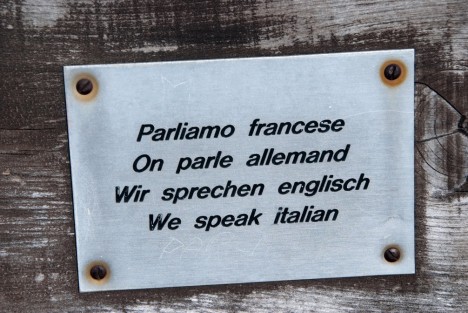Speaking is Believing: How We Speak Affects How We See the World
(CC BY-NC-ND 2.0) Eric Andresen/Flickr You’ve heard the expression, “Seeing is believing.” But let me tell you about a more profound adage: “How we speak becomes what we believe, which shapes how we see the world.” I learned this directly from the legendary architect and inventor R. Buckminster Fuller one evening in Indiana when I went to one of his lectures. I had first discovered Bucky through his book I Seem To Be a Verb while browsing the shelves of my college bookstore. Impressed with the book, I made sure to be there when Bucky came to campus to give a two-hour lecture. One of the topics he addressed was our use of language, and how it forms


(CC BY-NC-ND 2.0) Eric Andresen/Flickr
You’ve heard the expression, “Seeing is believing.” But let me tell you about a more profound adage: “How we speak becomes what we believe, which shapes how we see the world.”
I learned this directly from the legendary architect and inventor R. Buckminster Fuller one evening in Indiana when I went to one of his lectures. I had first discovered Bucky through his book I Seem To Be a Verb while browsing the shelves of my college bookstore.
Impressed with the book, I made sure to be there when Bucky came to campus to give a two-hour lecture. One of the topics he addressed was our use of language, and how it forms the way we see the world.
How crazy can language get?
Think for a moment about the biblical expression from Revelation 7:1, the four corners of the world. The earth is round, yet we still talk like it is flat, and because of that, we still see it that way. And how about our use of up and down in directions? “Y’all come on down to Florida.” What’s this down word? We are still stuck on that map on the wall. Going upstairs? We are really going outstairs. Pilots know we go out from the center of our large spaceship earth and return in when we land. Got a second to spare? Why do we call the smallest original unit of time a second? Shouldn’t it be a first?
There are endless examples of how we misuse language, and it is not innocuous: it shapes our thinking and creates false perceptions of reality. This might just be seen as trivial, but these false views are not as benign as we might think. Not only do they lead to incorrect thinking, as Bucky said, but they create serious misunderstandings and impede communication with speakers of other languages. The language we speak very clearly shapes the way we view the world.
And that’s just the tip of the language iceberg.
The languages we speak shape the way we see the world, the way we think, and the way we live our lives. People who speak different languages think differently simply because they speak different languages. In addition, learning a new language changes the way we think.
Of course, there are many other advantages to multilingualism beyond simply not misunderstanding others: You’ll have better job opportunities, a smarter brain, and even protection against dementia.
Interestingly, every language has distinctive variable differences, and this makes learning a new language much more difficult than just learning a new vocabulary It often requires looking at the world in different new ways so you can learn to choose your words in the new language and be understood, and you can understand others speaking that language.
People who are bilingual perspective of their world that depends on and varies with which language they are using. They may even feel like a different person because of the different emotional resonance associated with each language.
For example, people speaking German will tend to describe not only the action but also the outcome of the action, like “A woman walks towards her car.” In English we would be more likely to say “A woman is walking,” describing only the action itself. The reason for this appears to be because English identifies events that are ongoing by applying ing to words. The German language doesn’t have this.
There is an Aboriginal dialect that has a strong focus on space. Instead of using words like right, left, forward, and back, it uses directional terms like north, south, east, and west to define space. They may say things like “There’s an ant on your southeast leg” or “Move the cup to the north northwest a little bit.” If you are directionally challenged, you may want to avoid this language. If you’re asked, “Where are you going?,” your response needs to be something along the lines of, “South-southeast, in the middle distance.”
Even basic aspects of time perception can be affected by language. For example, English speakers talk about time in terms of length, using words like short and long, while Spanish and Greek speakers talk about time in terms of amount, using words like much, big, and little. Then there is the use of gender. English only has a small amount of this compared to many other languages where nouns are declined by gender, even when there is no sexual component to the noun.
These are just a few examples in a few languages. Imagine how challenging it must be for humans on this planet, speaking over 6,500 different languages, to really understand each other.
Lera Boroditsky, Ph.D., Associate Professor of Cognitive Science at the University of California, San Diego, summarizes:
“Languages shape the way we think about space, time, colors, and objects. Language affects how people construe events, reason about causality, keep track of number, understand material substance, perceive and experience emotion, reason about other people’s minds, choose to take risks, and even in the way they choose professions and spouses…. [T]he languages we speak profoundly shape the way we think, the way we see the world, the way we live our lives.”
It is not surprising that we have a difficult time understanding the way others think. It takes a real effort to understand others from an accepting point of view. When interacting with speakers of another language, consider the homily, “You can either be happy and have a relationship or be right.”
I’ve met people with whom I have no common language, and we could only communicate the most basic concepts. But it was obvious that we felt a connection based on compassion and kindness, things that all people, no matter the language, share. People do not have to be alike to get along. We just have to want to get along. If we put the importance of the relationship first in all things, maybe, just maybe, we can find the world harmony we all seek, and in doing so we may realize why we called that first unit of time a second after all.

By Dr. J, a maxillofacial surgeon living in Florida. Dr. J has travelled to Haiti to treat indigent patients and has taught as an associate professor at a Florida dental college. In his spare time Dr. J is a dedicated runner as well as a pilot who flies his Piper Cherokee Arrow throughout Florida. He has a black belt in karate. Dr. J has written for CalorieLab since 2007.
Speaking is Believing: How We Speak Affects How We See the World is a post from:
SOURCE: – Read entire story here.







